|
Datsun is an automobile marque. The name was created in 1931 by the DAT Motorcar Co. for a new car model, spelling it as "Datson" to indicate its smaller size when compared to the existing, larger DAT car. Later, in 1933 after Nissan Motor Co., Ltd. took control of DAT Motorcar Co., the last syllable of Datson was changed to "sun", because "son" also means "loss" (損) in Japanese, and also to honour the sun depicted in the national flag, hence the name
"Datsun" : Dattosan (ダットサン,
Dattosan?). Nissan phased out the Datsun brand in March 1986. The Datsun name is most famous for the sports cars referred to as the Fairlady roadsters and later the Fairlady (240Z) coupes. On March 20, 2012, it was announced that Nissan will revive the brand for use in Indonesia, India and
Russia.
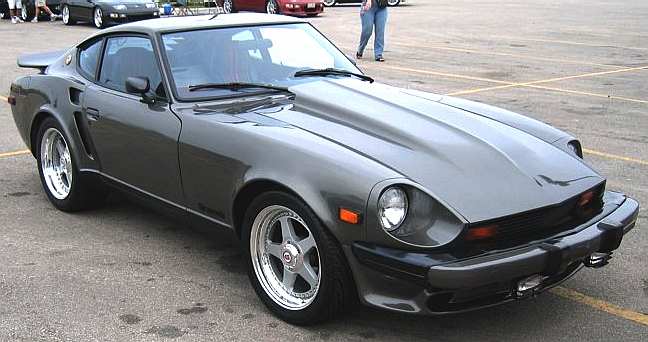
Before the Datsun brand name came into being, an automobile named the DAT car was built in 1914, by the Kaishinsha Motorcar Works (快進自動車工場, Kaishin Jidōsha Kōjō?), in the Azabu-Hiroo District in Tokyo. The new car's name was an acronym of the company's partners' surnames:
Kenjiro Den (田 健次郎, Den Kenjirō?)
Rokuro Aoyama (青山 禄朗, Aoyama Rokurō?)
Meitaro Takeuchi (竹内 明太郎, Takeuchi Meitarō?).
Conflicting information: What's in a Name? The Change From Datsun to Nissan By Daniel Banks "This despite Business Week’s error that Den, Aoyama, and Takeuchi founded Nissan. They did not, of course. Kenjiro Den, Rokuro Aoyama, and Meitaro Takeuchi were 3 financial backers and friends for one of the originators of the Japanese automobile industry, Masujiro Hashimoto, who founded Kaishinsha Jidosha Koto, or “Kaishinsha Motor Car Works” in
1911."
The firm was renamed Kaishinsha Motorcar Co. in 1918, seven years after their establishment and again, in 1925, to DAT Motorcar Co. DAT Motors constructed trucks in addition to the DAT passenger cars. In fact, their output focused on trucks since there was almost no consumer market for passenger cars at the time. Beginning in 1918, the first DAT trucks were assembled for the military market. The low demand from the military market during the 1920s forced DAT to consider merging with other automotive industries. In 1926 the Tokyo-based DAT Motors merged with the Osaka-based Jitsuyo Jidosha Co., Ltd. (実用自動車製造株式会社, Jitsuyō Jidōsha Seizō
Kabushiki-Gaisha?) also known as Jitsuyo Motors (established 1919, as a Kubota subsidiary) to become DAT Automobile Manufacturing Co., Ltd. (ダット自動車製造株式会社, Datto Jidōsha Seizō
Kabushiki-Gaisha?) in Osaka until 1932. (Jitsuyo Jidosha began producing a three-wheeled vehicle with an enclosed cab called the Gorham in 1920, and the following year produced a four-wheeled version. From 1923 to 1925, the company produced light cars and trucks under the name of
Lila.)
The DAT corporation had been selling full size cars to Japanese consumers under the DAT name since 1914
(Madely, pg. 19), but in 1930 the Japanese government created a ministerial ordinance that allowed cars with engines up to 500 cc to be driven without a license. (TOGO, pg. 11). DAT Automobile Manufacturing began development of a line of 495 cc cars to sell in this new market segment, calling the new small cars
"Datson" - meaning "Son of DAT". The name was changed to
"Datsun" two years later in 1933.(Madely, pg. 20)
The first prototype Datson was completed in the summer of 1931.(Nissan). The production vehicle was called the Datson Type 10, and "approximately ten" of these cars were sold in 1931.
(JSAE). They sold around 150 cars in 1932, now calling the model the Datson Type 11(JSAE). In 1933 the government rules were revised to permit 750 cc engines, and Datsun increased the size of their microcar engine to the maximum size allowed
(JSAE). These larger displacement cars were called the Datsun Type 12.(Nissan Heritage)
DATSUN IN THE USA
The "classic" Datsun logo, based on the Flag of Japan and Japan's nickname as the "Land of the Rising Sun". After the Nissan
rebrand, the logo remained the same, with "Datsun" replaced by
"Nissan".The use of the Datsun name in the American market derives from the name Nissan used for its production cars. In fact, the cars produced by Nissan already used the Datsun brand name, a successful brand in Japan since 1932, long before World War II. Before the entry into the American market in 1958, Nissan did not produce cars under the Nissan brand name, but only trucks. Their in-house designed cars were always branded as
Datsuns. Hence, for Nissan executives it would be only natural to use such a successful name when exporting models to the United States. Only in the 1960s did Nissan begin to brand some automobile models as Nissans, and these were limited to their high-end models, for example the Cedric luxury-type sedan. In America, the Nissan branch was named "Nissan Motor Corporation in U.S.A.", and chartered on September 28, 1960, in California. Nissan may have had no problems with using the name Nissan in America, but the small cars the firm exported to America were still named
Datsun.
Corporate choice favoured “Datsun”, so as to distance the parent factory Nissan’s association by Americans with Japanese military manufacture. In fact Nissan's involvement in Japan's military industries was substantial. The company's car production at the Yokohama plant shifted towards military needs just a few years after the first passenger cars rolled off the assembly line, on April 11, 1935. By 1939 Nissan's operations had moved to Manchuria, then under Japanese occupation, where its founder and President, Yoshisuke
Ayukawa, established the Manchurian Motor Company to manufacture military trucks.
Ayukawa, a well connected and aggressive risk taker, also made himself a principal partner of the Japanese Colonial Government of
Manchukuo. Ultimately, Nissan Heavy Industries emerged near the end of the war as an important player in Japan’s war machinery. After the war ended, Soviet Union seized all of Nissan’s Manchuria assets, while the Occupation Forces made use of over half of the Yokohama plant. General MacArthur had Ayukawa imprisoned for 21 months as a war criminal. After release he was forbidden from returning to any corporate or public office until 1951. He was never allowed back into Nissan, which returned to passenger car manufacture in 1947 and to its original name of Nissan Motor Company Ltd. in 1949.
Datsun
Fairlady
American service personnel in their teens or early twenties during the Second World War would be in prime car-buying age by 1960, if only to find an economical, small second car for their growing family needs. Yutaka Katayama, (Mr. "K") former president of Nissan's American operations, would have had his personal second world war experiences in mind supporting the name
Datsun. Katayama's visit to Nissan’s Manchuria truck factory in 1939, made him realise the appalling conditions of the assembly lines, leading him to abandon the firm.[6] In 1945, near the end of the war, Katayama was ordered to return to the Manchurian plant, however he rebuffed these calls and refused to return.
Datsun 240Z (USDM) or Fairlady Z (JDM)
Katayama desired to build and sell passenger cars to people, not to the military; for him it was the name
"Datsun" that survived the war with its purity intact, not "Nissan". This obviously led Katayama to have problems with the corporate management. The discouragement felt by Katayama as regards his prospects at Nissan, led to his going on the verge of resigning, when Datsun’s 1958 Australian Mobilgas victories vaunted him, as leader of the winning Datsun teams, to national prominence in a Japan bent on regaining international status.
Katayama was made Vice President of the Nissan North American company in 1960, and as long as he was involved in decision making, both as North American Vice President from 1960 to 1965, and then President of Nissan Motor Company – USA from 1965 to 1975, the cars were sold as
Datsuns. “What we need to do is improve our car’s efficiency gradually and creep up slowly before others notice. Then, before Detroit realizes it, we will have become an excellent car maker, and the customers will think so too. If we work hard to sell our own cars, we won’t be bothered by whatever the other manufacturers do. If all we do is worry about the other cars in the race, we will definitely
lose.”
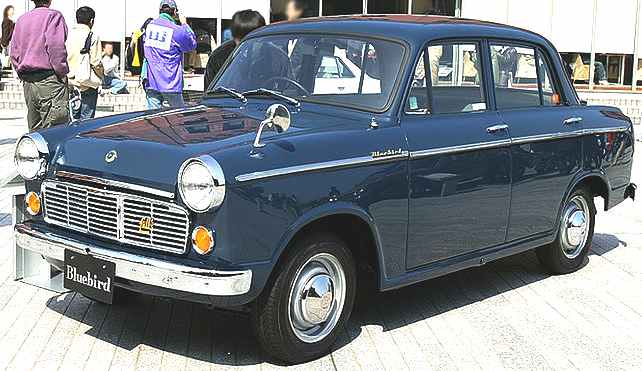
DATSUN
BLUEBIRDS
The Datsun
Bluebird 910 is an automobile which was produced by Nissan from 1979 to 1993.
Nissan began realigning its export names with the home market with the 910 series in November 1979. The 'B' tags were dropped in favour of 'Bluebird', though the models were
'Datsun Bluebird' initially. The body style options remained the same but the look was characterized by a boxy style, considered modern at the time.
For the export models, a 'Nissan' badge began appearing in 1981, and the following year the Datsun name disappeared.
The Maxima name first appeared in this generation. In the United States, these models were sold as the 810 Deluxe or
Maxima. The Maxima name was solely used from 1982. The 910 name was never used in
Australia.
This is the generation that spawned the S130 Fairlady Z, F30 Nissan Leopard, and in turn, the Z31 and Z32 Fairlady Zs using updated versions of the platform of this generation.
HISTORY
Datsun 1000 (210 series)
Although Nissan's own materials indicate that the
Bluebird name emerged in 1959, some records show that the name first adorned a 988 cc, 34 hp (25 kW) four-door sedan in 1957, which was part of the company's 210 series. Its engine was based on an Austin design, as Nissan had been building the Austin A50 Cambridge under licence in the 1950s.
The 210 was known for doubling Nissan's production at the time and was the first Nissan to be exported to the United States. In some markets, this model was exported as the Datsun 1000. It was the first passenger car to be built in
Taiwan, by the fledgling Yue Loong works, as the 1960 YLN 701
Bluebird
The Datsun 1000 series U220 truck was based on the series 210The 210 established an early reputation for reliability, with two of them winning the 1,000 cc class in the 1958 Australia Mobilgas Rally.
The 210 had succeeded the 110 series, sold as a two- and four-door sedan and offered from 1955 to 1957. This model bore the Convar or A110 model names and was powered by an 860 cc, 25 hp (19 kW) Nissan D10 four-cylinder engine. In some respects, the A110 is the forerunner of the modern Bluebird line. Incremental changes were denoted by 112 and 113 codes (the 111 designation was skipped), with the last model a 113 with the 210's 1-litre C engine. The Datsun 114 was introduced in October 1957 as a low cost option to the 210 (the 114 used the 210's body except for the grille and exterior trim combined with the old D10 engine). Another low cost alternative was the Datsun 115 (lower specification version of the 211) and was similar to the 114 with the exception of a bigger rear window and slightly redesigned front turn signals. The same engine was used, but was improved to produce 27 hp (20 kW).
1959 Datsun 1000 (series 211)Subsequent models included the 211 (October 1958) with cosmetic changes. There was also a U220-series of small trucks based on the 210.
Datsun Bluebird 310 - also called Yue Loong Bluebird 704
The Datsun Bluebird which debuted for August 1959 was an all-new car, and was available in Japan at the dealership sales channel Nissan Exhibition. The 310 series had a 1 L engine from the 210 model. The 310 was built from 1960-1963. There were three models built: 310 (1960), 311 (1961), and 312 (1962–1963). In Taiwan it also replaced the 701 and was known as Yue Loong Bluebird 704. The Datsun 312 was also sold in Korea.The 310 series was also built in South Africa at a factory in Rosslyn Pretoria in CKD form during 1962 and 1963.
In July 1960, a five-door station wagon was added (WP310). The P310 was powered by the 1.2L Nissan E engine. A smaller engine version (simply called "310") was powered by the 1.0L Nissan C engine. The P311 and P312 (powered by the 60 hp 1.2L Nissan E-1 engine) also had smaller engined versions ("311" and "312") that were powered by the 45 hp 1.0L Nissan C-1 engine. The 310 and 311 were equipped with a 3-speed manual transmission (fully synchronized for the 311 and 312). The station wagon was also available for the 311 and 312. The 312 was also available in a deluxe version (DP312). A trim model called the "Fancy Deluxe" (model code DP312-L) was marketed for the female driver; it featured a pale yellow exterior, pale
yellow/grey interior, high heel shoe holder under the dash, a vanity mirror on the back of the driver's side sun visor, a turn signal relay that played music, curtains, automatic clutch, and bigger mirrors. By February 1961, a 1.2 L overhead-valve engine (codenamed E-1) became an option on a higher-trim DX model.
Styling tended to ape larger American cars. A very small number did make it to the United States, but were flops. This generation Bluebird became one of the first Japanese cars to be sold in serious numbers in Europe, after Finland fully opened its doors to automobile imports in mid-1962. 700 were brought in, and by the time the 410-series had arrived, Datsun had passed SAAB and Triumph in registrations. Although not very fast, the sturdy Datsun was well-suited to the rugged Finnish roads of the
time.
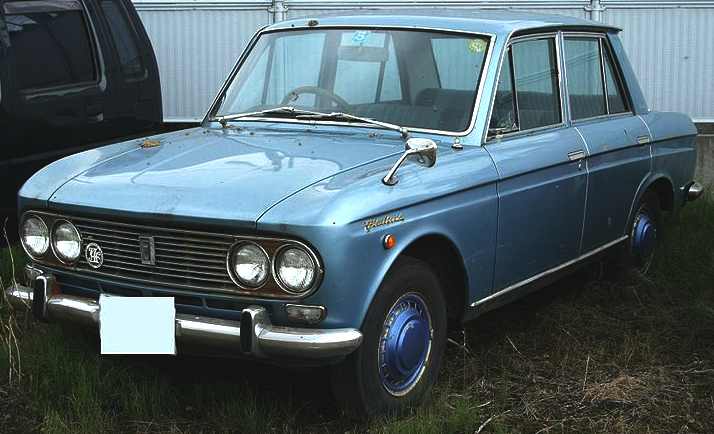
Datsun Bluebird 410
In September 1963, Nissan brought the Bluebird up-to-date with boxier styling (by
Pininfarina), resembling European designs. The 410 was built from 1964-1967.
Two basic models were built: 410 (1964–1965) with a combination rear lamp set consisting of round and rectangular lenses, and 411 (1965–1967), which featured the same combination rear lamp set as the earlier 410 through 1966, changing to higher mounted rectangular tail light sets for 1967. On both, the rear direction indicators were red or amber, according to market – New Zealand, which allows either, took the 410 with both and the 411 with red only. This Bluebird was one of the first Japanese car lines assembled in New Zealand, initially imported under a tariff/duty arrangement allowing 300 cars a year (the so-called '300 Club') with CKD kits built up by Motor Holdings at Mount Wellington in Auckland. The 410 series sedan and station wagon plus a light delivery van was assembled in
South Africa at a factory in Rosslyn Pretoria. These cars were all in CKD format.
A sporting model, the Bluebird SS, was launched in Japan in March 1964, with a tuned 1.2 L engine. The SS was originally available only in a four-door configuration
(MTK), but a two-door (RTK) joined about a year later. Two versions of the SS were built: the
DP410-MTK/RTK and the DP411-MTK/RTK. The DP410 was powered by a 71 hp (53 kW) version of the 1.2 L Nissan E-1 engine. The 78 PS (57 kW)
double-carburetted version of the J13 powered the DP411. All SS models were equipped with a four-speed manual transmission.
Initially, only a four-door sedan and five-door station wagon were in the range, but a two-door was added in September 1964. The two-door SS was launched in February 1965. The 410 and 411 were also available in a deluxe version (DP410 and DP411). A "Fancy Deluxe" version was also available in the home market. A DP411 SSS was entered in motor sport by the Datsun factory in South Africa and was used as test car for Nissan
Japan. A Datsun DP411 SSS was also entered in the 1964 Monte Carlo rally, where it was driven by a South African called Ewold van Bergen.
In May 1965 the base engine was enlarged to a downtuned version of the 1.3 L unit already used in the SS, now with a single (twin-barrel) carb and developing 67 PS (49 kW) at 5,200 rpm. The transmission remained a
three-speed. The SS was downtuned somewhat, now with 72 PS (53 kW) but still with the four-speed
unit. More excitingly, a twin-carb 1.6 L SSS model was launched the same month, with no less than 90 PS (66
kW). This begat a line of famous Nissans in Japan, with the Bluebird SSS a mainstay of the range until its deletion in 2001.
In the United States, only the four-door sedan and wagon were offered; the two-door was never available. The 1.6
litre, featuring the same R16 engine as the SP(L)311 Roadster, was only available in 1967. The 1.2 and 1.3 410 and 411 series' had a manual gearbox, while the 1.6 litre was available as either a manual or automatic. The cars were labeled
DATSUN, with no mention of Bluebird either on the car or in the owner's manual.
In Taiwan the Bluebird 410 was built and sold as the Yue Loong YLN-705B.
510 seriesDatsun Bluebird 510
Datsun Bluebird "SSS" series 510 coupe
Launched in August 1967, it was one of the most comprehensive Bluebird ranges in terms of body styles: a two-door sedan, a four-door sedan, a five-door station wagon, and a two-door coupé (added in November 1968). The "510" still enjoys considerable fame in the US.
Like its predecessors, the 510 Bluebird line was imported into New Zealand as a single 1.6-litre, four-speed manual Deluxe model, assembled from CKD kits by Campbell Industries (later Toyota New Zealand Thames assembly plant). Local content included glass, radiator, upholstery, carpet, paint, wiring and numerous other items. A few automatic and twin carburettor SSS versions were imported built-up from Japan, primarily for buyers who had access to funds overseas and could utilise the country's 'no remittance' new car purchase scheme to avoid lengthy waiting lists.The P510 sedan and coupe were built in South Africa [Pretoria] from 1969 to 1974 and had the L16 1600SSS twin carbs and the 1600 Deluxe single
carb. An automatic gearbox model was also available for the deluxe range. The factory also made two versions of the 2 door coupe. They were a 1600GL and a 1800GL. The 1600GL had a single carb or twin carbs and 1800 cc cars had twin carbs The 1600sss were also used in motorsport as test cars for Nissan Japan. The cars were used in numerous motorsport rallies by Ewold van Bergen from Pretoria, South Africa, who was a test engineer for Nissan Japan.
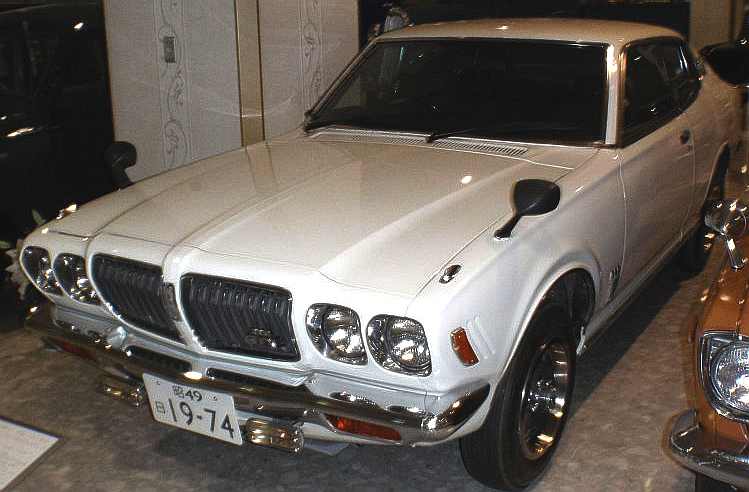
Datsun Bluebird 610
1974–1977 Datsun 180B (P610) sedan (Australia)
The 610 series was launched in Japan in August 1971 and was badged as the Datsun Bluebird-U. The meaning behind the U suffix is uncertain, but it has been suggested that it was an acronym for either User or Ultra. For the Japanese domestic market, the 610 was pitted against the second generation Toyota Corona Mark II. Also in Japan, the 610 was initially sold alongside the 510 but eventually replaced the 510. 610's were available in a 4dr, 2dr hardtop (HT), and five-door wagon. Trim levels in Japan were GL (Grand Luxe), SSS (Super Sports Sedan), DX (Deluxe) or STD (Standard). The 610 borrowed its suspension and drive train from the outgoing 510. Thus all 610's were equipped with the Nissan L-Series inline engines. Likewise, the 610 4dr & 2dr retained the class-leading, independent rear trailing arm design, while the wagon reused the rear live axle with leaf springs from the 510 wagon. In many export markets, including UK, Europe & Australia, the 610 was badged as the 160B or 180B with respect to particular engine displacement.
From 1973-74, the USA was the only market outside of Japan to have its 610 HT models equipped with the unique, six-bulb tail lights that covered the entire rear panel, requiring the license plate to be mounted below the rear bumper. Most 610's world- wide came equipped with either a 4spd manual or 3spd automatic transmission, but a 5spd manual transmission was available in the Japan & Australia markets. As with the 510, SSS trim included misc. sport options and a higher output
engine with twin-Hitachi carburetors. A Japan-only
SSS-E model was equipped with Bosch EFI, and so was one of the first, mass-produced Nissan vehicles to be sold without a carburetor. Another 610 never exported was the inline-six -U-2000 GT and -U-2000 GTX(SAMEBLUE..SAME meaning Shark in Japanese). It came with stretched front end to accommodate the longer engine and featured a different grill and other aesthetic modifications, but this model was not available in a wagon.
New Zealand market cars initially were a single 1.8-litre 180B sedan, again with four-speed manual transmission and assembled from CKD kits under contract by Campbell's. A three-speed automatic – using a transmission made by Nissan Japan subsidiary JATCO – was later added as a factory option. Relaxed restrictions on car assembly kit imports and increasing affluence in NZ meant Campbell's, which also assembled Toyota, Renault, Rambler, Hino, Isuzu and Peugeot models over the years, could not meet demand so
Nissan-Datsun (NZ) contracted Chrysler/Mitsubishi importer Todd Motors to assemble additional manual 180Bs at its Porirua factory alongside the Chrysler Valiant, Hunter, Avenger and Alpine model ranges and Mitsubishi Lancer sedan and Colt Galant coupe. The Todd-built cars gave Datsun dealers a new range of paint colours all different to those Campbell's offered.
A minor upgrade to the front suspension (offset strut tops) for the 610 led to slightly improved handling before the introduction of the 810. Racing History
A 610 4dr participated in the 1972 & 1973 East African Safari Rally. Bob Sharp drove his 610 HT race car to 2nd place overall in the SCCA B Sedan Championship for 1973 & 1974. The same car achieved a first place for the 1976 SCCA B-Sedan Championship but with Elliot Forbes-Robinson driving.
710 series
Nissan Violet 710 series sedan
Shortly after the introduction of the 610, Nissan launched a new line of slightly smaller cars January 1973 utilizing parts and styling cues from the 610. This new line of cars was sold in various markets as the 140J/160J, Violet, or 710, evolving into the Nissan Stanza. The use of the 710 name was a source of confustion because it implied that the model was either a larger, upscale version of the 610 (it was the opposite) or a newer model in the Bluebird line.This car was also built in South Africa during 1973 to 1978 at the Rosslyn Datsun plant in the form of a 160U deluxe and SSS and 180U deluxe and SSS. As the Bluebirds traditional cross-town rival, the Toyota Corona split into a new model called the Toyota Carina, the Violet appeared shortly after the Carina did.
Datsun Bluebird 810
The 810 was introduced in July 1976. Engine options were carried over but a 1.4 L was reintroduced in August 1978. Styling was an evolution of the 610's, with slightly squared off features but retaining a slight "coke bottle". No two-door sedan was available, but the four-door sedan, two-door hardtop coupé ( SSS Coupe) and five-door station wagon were offered.
The Bluebird 810 was sold in export markets as the Datsun 160B, Datsun 180B, Datsun 200B and Datsun
810. Australian magazine Wheels calling the 200B 'a 180B with 20 more mistakes.'
At this time, with several UK auto-producers losing market share, Datsun had grabbed the headlines as the UK's leading car importer. The magazine Autocar road tested a 180B Bluebird and recorded a top speed of 101 mph (162 km/h) along with a 0-60 mph (0 – 96 km/h) time of 13.6
seconds. The Datsun's overall fuel consumption for the test was 27.7 mpg (10.2 l/100
km). For all three of these performance measurements, it was marginally better than the Ford Cortina 1600 GL which continued to dominate this sector in the UK, but both cars were beaten for speed and acceleration (though not for fuel economy) by the relatively crude Morris Marina
1.8HL. It was probably more significant that the Bluebird had a manufacturer's recommended retail price, including sales taxes, of £2950 as against £3263 for the Ford and £3315 for the
Morris. The testers found the car matched the competition in most respects, though the brakes were criticised for being "not up to current
standards".
This Bluebird was the first to be assembled in Nissan New Zealand's own brand-new assembly plant at
Wiri, South Auckland. It was originally built as a 180B but that was replaced by the
two-litre 200B during the run. Automatic transmission was optional for both. Nissan also added its first luxury ZX version with this generation – features included velour upholstery, 'luxury' cut-pile carpet sourced locally and tinted glass. There was also, for the first time in Kiwi assembly, a wagon variant with mid-range trim and equipment.
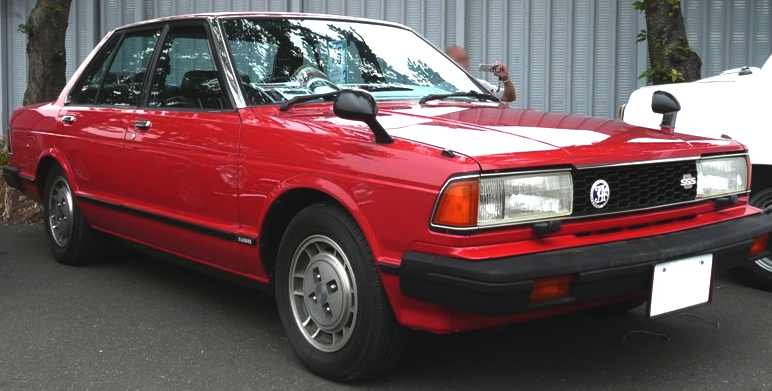
Datsun Bluebird 910
Also called Nissan Bluebird 910
The Bluebird 910, which was the last rear wheel drive Bluebird, featured simple clean-cut lines, unlike the "Coke Bottle" styling of its
predecessor. It did however retain the same engine range, the same McPherson strut suspension and the same 99-inch (2,500 mm) wheelbase as the
810.
This car was made in South Africa[Pretoria]1978 to 1980 as well and was called the Datsun 1600J Deluxe,1800j deluxe or 1800J SSS Sedan which had the twin carb set up and a five speed gearbox.A staton wagon version with a 1600 cc engine was also made.The cars had the L16 or L18 engines.After a while the cars model name changed to the Datsun Stanza.The cars were all rear wheel drives with solid axle and coil springs.These cars were the last models to have the name DATSUN as the later models all had the name NISSAN due to the globel name change. This car was very popular as it reminded people of the Datsun P510 models made in 1969 to 1973 in South Africa.
Nissan began realigning its export names with its home market names with the 910 series in November 1979. The 'B' tags were dropped in favour of 'Bluebird', though the models were marketed as
'Datsun Bluebird' initially. For the export models, a 'Nissan' badge began appearing in 1981. However in Australia, where 130,000 910s were built between 1981 and 1986, the name change from Datsun Bluebird to Nissan Bluebird did not occur until
1983.
After eight years the Bluebird returned to the Taiwanese market. Yulon had replaced the Bluebird with the Nissan Violet in 1971. The new model was considered to be in a new class and was now known as the Yue Loong Bluebird 911. Until then, Yue Loong had reserved the 900-series for the larger Laurels. After a facelift, the car became the
912.
Nissan New Zealand assembled several versions of the Bluebird 910. These were shipped in CKD from Japan, including a top ZX model that was the first, and only, car to be assembled in the country with electrically adjustable Japanese domestic style 'hockey stick' rear view mirrors on the front guards (which had to be sent out after kit unpacking for a local specialist to stamp the mounting holes). NZ cars initially had the two-tone brown interior; this was switched to grey at the mid-life facelift when the top model's power exterior mirrors were relocated to the door mounting now universal today. Japan itself eventually phased out the mandatory wing-mount mirrors that also distinguished thousands of used cars imported from Japan into NZ in the late 1980s and early 90s.
Nissan Bluebird U11 -
Also called Yue Loong Bluebird 931 (Yulon, TW)
The Bluebird switched to front-wheel drive in October 1983 but retained the boxy styling of its predecessor. At the time, Nissan's design chief balked at curvy shapes and believed boxy ones would remain popular. With hindsight, that went directly against the trend and the market's obsession with drag coefficients.
The range was offered in four-door sedan, four-door hardtop and five-door station wagon forms. The coupé was deleted.
Australia made do with the 910 series, which was facelifted in 1985.
New Zealand marketing for the U11 proclaimed the vehicle as the 'Widetrack Bluebird', to differentiate it from its very similar-looking predecessor. Several
Wiri-assembled models including a wagon were offered with 1.6 (base) or two-litre carburettor engines. The alloy head castings all had an unused location for a second spark plug per cylinder, eight-plug, fuel-injected versions of the same engines were used in some markets (US, Japan, Scandinavia) with stricter emission laws.
This model was offered in Europe for two years before Nissan began building the Auster as the Bluebird in England in 1986.
The U11 was sold as the Yue Loong Bluebird 931 in Taiwan.
Although the U11 sedans were replaced for the 1988 model year, the station wagon continued in to 1990.
The range was available with 1.6, 1.8 and 2.0L petrol engines. The VG20ET V6 was offered for the first time in Japan in 1984, in a model with an extended front end, called the Bluebird Maxima.This V6 was intercooled 2.0L V6 turbo.
In the United Kingdom, the following versions were offered:
1.8 DX (1984–86)
2.0 GL/GL estate/SGL (1984–86)
1.8 Turbo ZX (1984–86)
REBRANDING
Datsun 720
In Japan, there appears to have been what probably constituted a long held 'official' company bias against use of the name
“Datsun”. At the time, Kawamata was a veteran of Nissan, in the last year of his presidency, a powerful figure whose experience in the firm exceeded two decades. His rise to its leadership position occurred in 1957 in part because of his handling of the critical Nissan workers' strike that began May 25, 1953, and ran for 100 days. During his tenure as President, Kawamata stated that he "regretted that his company did not imprint its corporate name on cars, the way Toyota does. ‘Looking back, we wish we had started using Nissan on all of our cars,’ he says. ‘But Datsun was a pet name for the cars when we started exporting.’
”
Ultimately, the decision was made to stop using the brand name Datsun worldwide, in order to strengthen the company name Nissan.
“The decision to change the name Datsun to Nissan in the U.S. was announced in the autumn (September/October) of 1981. The rationale was that the name change would help the pursuit of a global strategy. A single name worldwide would increase the possibility that advertising campaigns, brochures, and promotional materials could be used across countries and simplify product design and manufacturing. Further, potential buyers would be exposed to the name and product when traveling to other countries. Industry observers, however, speculated that the most important motivation was that a name change would help Nissan market stocks and bonds in the U.S. They also presumed substantial ego involvement, since the absence of the Nissan name in the U.S. surely rankled Nissan executives who had seen Toyota and Honda become household
words.”
Ultimately, the name change campaign lasted for a three year period from 1982 to 1984
(Datsun badged vehicles had been progressively fitted with small "Nissan" and
"Datsun by Nissan" badges from the late 1970s onward) until the Nissan name was given prominence in 1983 - although in some export markets vehicles continued to wear both the Datsun and Nissan badges until 1986. The name change had cost Nissan a figure in the region of US$500 million. Operational costs included the changing of signs at 1,100 Datsun dealerships, and amounted to US$30 million. Another US$200 million were spent during the 1982 to 1986 advertising campaigns, where the “Datsun, We Are Driven!” campaign yielded to “The Name is Nissan” campaign. (The latter campaign was used for some years beyond 1985.) Another US$50 million was spent on Datsun advertisements that were paid for but stopped or never
used. Five years after the name change program was over, Datsun still remained more familiar than
Nissan.
2014 RELAUNCH
On March 20th 2012 Nissan announced a plan to revive Datsun as a low-cost marque, 31 years after removing it from its line-up. The Japanese carmaker said the brand's reputation for value and reliability would help it in emerging markets. Datsun models will be sold in Indonesia, Russia and India from 2014. Nissan has not decided where the Datsun-branded cars will be produced, but a spokesman said that it was likely to be in Asia.
Will Datsun produce electric cars and will they suffer from range
restrictions, as with the vast majority of pure EVs being built today.
Perhaps Datsun will be involved in the move to standardize battery
cartridges so that EV service
stations may become a viable proposition.
REFUELING
FOR EVs - Any
form of electric vehicle is better than petrol or diesel, but an
electric vehicle that can refuel in a few minutes will obviously have
much more customer appeal than an EV that has to wait 30 minutes or
even hours to charge up.
Battery
technology is improving daily. A car with the new generation of
battery cartridge exchange built in and the ability to load its own
cartridge, will encourage energy companies to build service
forecourts.
The
Blueplanet Ecostar (BE3) LSR Team would be pleased to advise any
energy company interested in this technology and of course any vehicle
manufacturer who might be considering whether or not to include a
future proof system into their next generation of road cars.
Please
click on the links above to find out about these famous automotive
makers. If your company is not included and you would like to be
listed, please let us know.
UK
VEHICLE INSURANCE ONLINE A - Z
No
matter what car, van or bike you drive, we're all looking for great
value and quality in our UK motor insurance? But who is the best
- who is the cheapest and who offers the great service in the event of
a claim?
See
the insurance companies below who claim to offer competitive cover at
sensible prices, our
guide to the jargon and tips for cutting your quote - Good
Luck:-
Automotive
Prehistory Links
CONTACTS
A
taste for adventure
capitalists
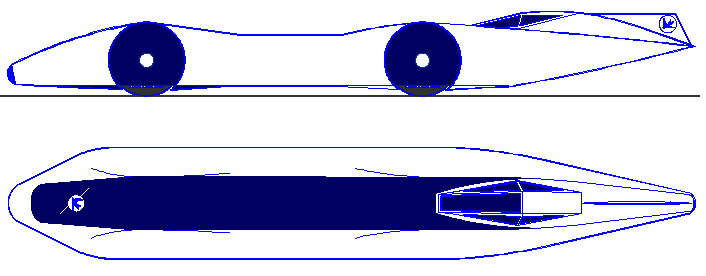
The
world's fastest electric car: 350mph + using energy from nature.
Featuring built in battery cartridge exchange, charged using renewable
solar energy. Sponsors sought for the 2016 season.
|





